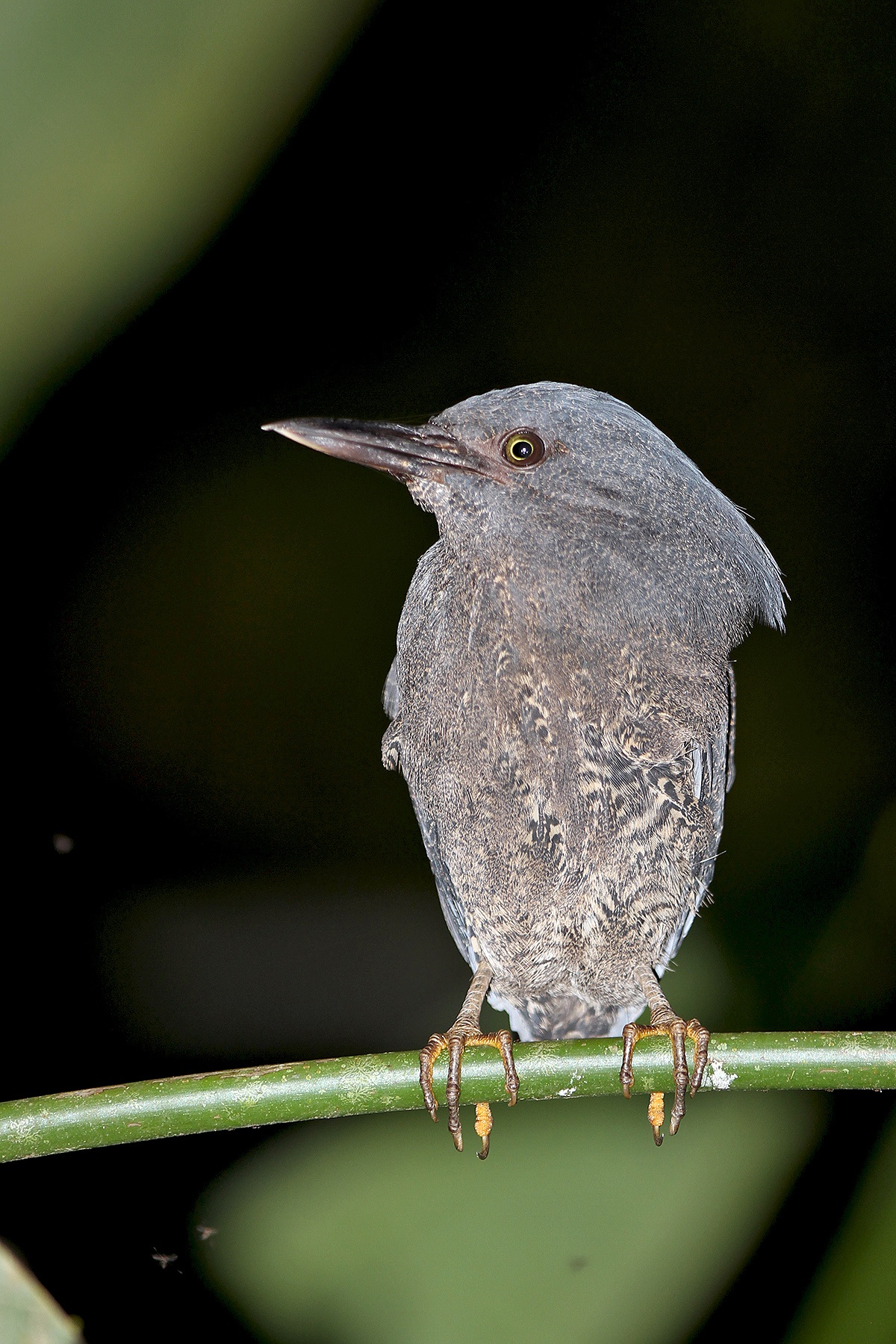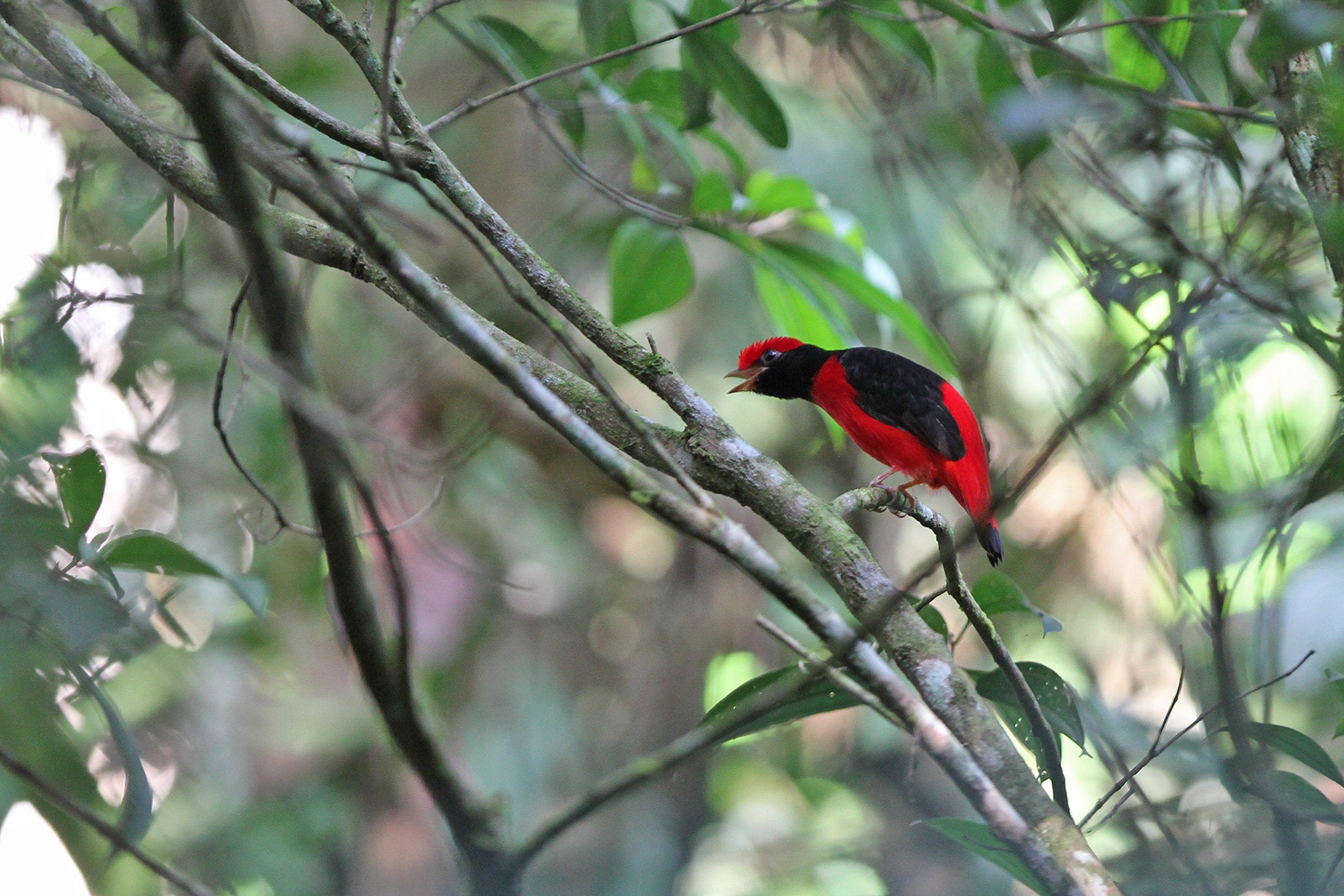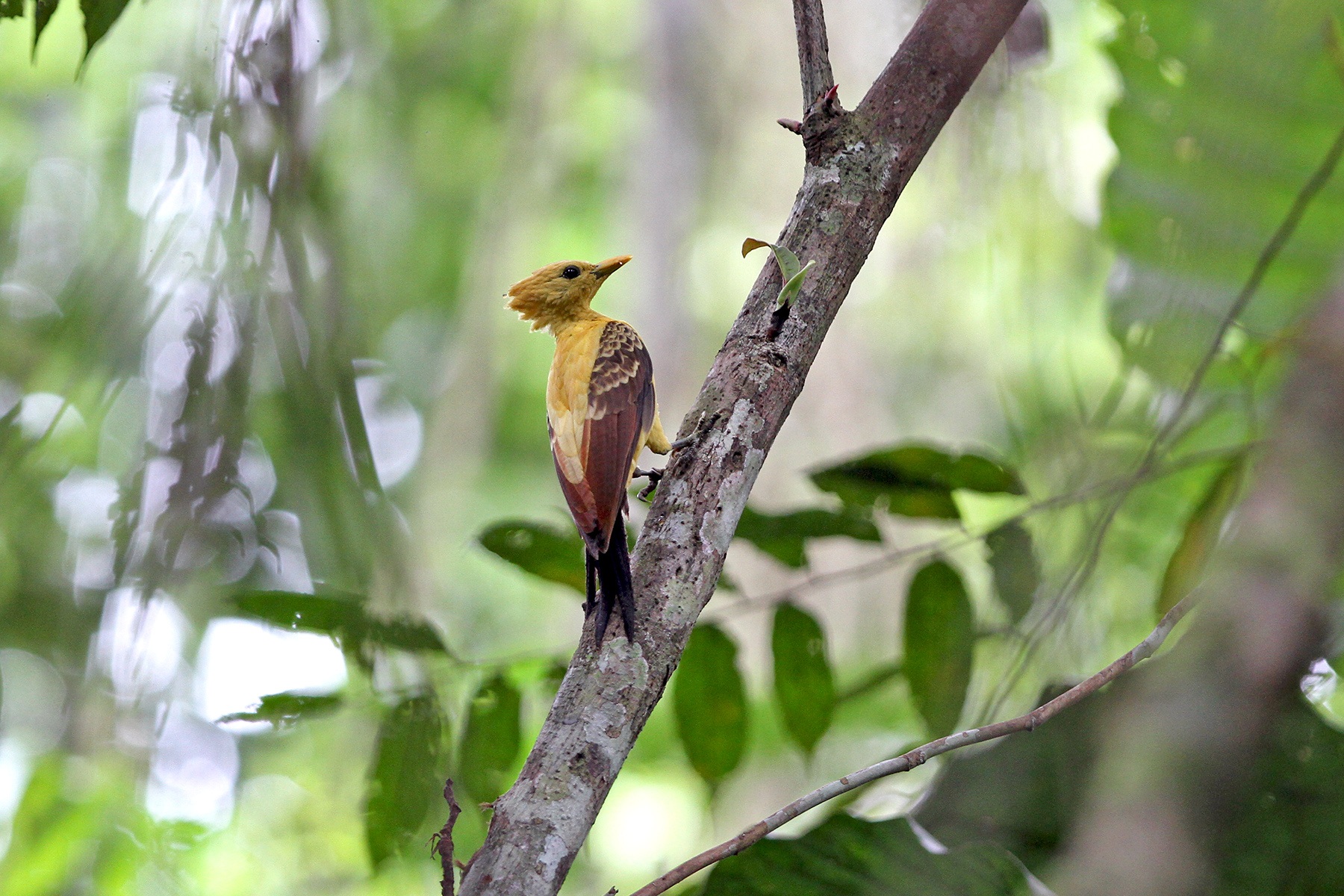AMAZONIAN ECUADOR BIRDING TOUR: DETAILED ITINERARY
Amazonian Ecuador: Day 1 Our tour begins this evening with an overnight stay near Quito airport. Airport transfers will be provided.
Amazonian Ecuador: Day 2 This morning a short flight will take us across the high eastern Andes and then down into the vast wilderness of Amazonia. If the weather is clear we will have spectacular views of Cayambe and then verdant lowland forests extending far into the distance. Upon landing at Coca airport, we will travel to the research station at Rio Bigal Biological Reserve for a three nights stay. The last hour of our journey is a straightforward hike, with all our luggage carried by horses or mules.
Amazonian Ecuador: Days 3-4 The extensive Rio Bigal Biological Reserve protects an extensive area of lowland rainforest and foothill forest at the base of the Andean foothills of Ecuador. This little-visited place has a superb avifauna and we are going to enjoy seeking out its specialities during our stay.
Major restricted-range specialities here include the attractive Pink-throated Brilliant and the localized Blackish Pewee (both of which we have a good chance of seeing). There are also fair chances for such specialities as Nocturnal Curassow, Marbled Wood Quail, Grey-winged Trumpeter, Military Macaw and Ecuadorian Piedtail. We will also have a chance for the wonderful Pavonine Quetzal. The restricted-range Red-winged Wood Rail occurs here, but we would have to be extremely lucky to set eyes on one.
Amongst the many other species we could encounter at Rio Bigal are Little and Undulated Tinamous, Scaled, Band-tailed, Plumbeous and Ruddy Pigeons, Ruddy and Blue Ground Doves, Sapphire and Ruddy Quail-Doves, Smooth-billed Ani, Squirrel Cuckoo, Blackish Nightjar, White-chested, Chestnut-collared, White-collared and Grey-rumped Swifts, Buff-tailed Sicklebill, Pale-tailed Barbthroat, Tawny-bellied and Grey-chinned Hermits, Blue-fronted Lancebill, Lesser Violetear, Black-eared Fairy, Black-throated Brilliant, Amethyst Woodstar, Glittering-throated Emerald, Golden-tailed Sapphire, Swallow-tailed and Plumbeous Kites, Ornate Hawk-Eagle, Great Black Hawk, Foothill Screech Owl, Green-backed and Blue-crowned Trogons, Rufous Motmot, Great Jacamar, Red-headed Barbet, Yellow-throated Toucan, Rufous-breasted Piculet, Yellow-tufted, Little, Lineated, White-throated and Spot-breasted Woodpeckers, Barred and Lined Forest Falcons, White-eyed Parakeet, Red-billed and Blue-headed Parrots, Southern Mealy Amazon and Chestnut-fronted Macaw.
Amongst a superb range of passerine birds are Fulvous, White-shouldered and Russet Antshrikes, Plain Antvireo, Foothill Stipplethroat, Slaty and Plain-winged Antwrens, Black, Blackish, Hairy-crested and Spot-backed Antbirds, Scaled and Thrush-like Antpittas, Striated Antthrush, Olivaceous, Long-tailed, Plain-brown, Olive-backed and Montane Woodcreepers, Red-billed and Brown-billed Scythebills, Plain Xenops, Rufous-rumped, Buff-fronted, Cinnamon-rumped, Montane, Rufous-tailed and Ruddy Foliage-gleaners, Striped Woodhaunter, Dwarf Tyrant-Manakin, Green and White-crowned Manakins, Fiery-throated Fruiteater, Grey-tailed and Screaming Pihas, Black-crowned and Masked Tityras, Golden-faced Tyrannulet, Marble-faced Bristle Tyrant, Black-and-white Tody Flycatcher, Olivaceous Flatbill, Mottle-backed Elaenia, Tawny-breasted, Olive-striped, Ochre-bellied, Slaty-capped, Ornate, Olive-chested, Short-crested, Social and Lemon-browed Flycatchers, Olivaceous, Tawny-crowned and Rufous-naped Greenlets, Turquoise Jay, Blue-and-white, White-thighed and Southern Rough-winged Swallows, Scaly-breasted, Wing-banded, House, Thrush-like, Coraya, White-breasted Wood, Chestnut-breasted and Musician Wrens, White-necked, Lawrence’s and Black-billed Thrushes, Thick-billed, Bronze-green and Orange-bellied Euphonias, Yellow-throated Bush Tanager, Yellow-browed and Orange-billed Sparrows, Russet-backed, Green, Crested and Olive Oropendolas, Yellow-billed and Yellow-rumped Caciques, Tropical Parula, Slate-throated Redstart, Olive, Magpie, Rufous-crested, Flame-crested, White-lined, Silver-beaked, Orange-eared, Yellow-bellied, Spotted, Masked, Blue-necked, Paradise, Opal-rumped, Opal-crowned, Bay-headed, Green-and-gold, Golden and Yellow-backed Tanagers, Fulvous Shrike-Tanager, Blac-faced and Blue Dacnises, Purple and Green Honeycreepers, Blue-black Grassquit, Chestnut-bellied Seed Finch, Bananaquit, Yellow-shouldered Grosbeak and Buff-throated Saltator.
Nearctic migrants, seasonally present, include Olive-sided Flycatcher, Western Wood Pewee, Barn Swallow, Swainson’s Thrush, Canada Warbler, Summer Tanager and occasionally Cerulean Warbler.
Amazonian Ecuador: Day 5 After some final birding at Rio Bigal we will drive to the upper Napo region region for a four nights stay.
Amazonian Ecuador: Days 6-8 We will devote most of our time in the upper Napo region to visits to reserves where we can explore the rolling terra firme forest and the upper reaches of the Napo River, soon after it debouches from the Andes. This exciting, bird-rich Amazonian habitat, dominates the local landscape.
We will look for fruiting trees which might attract Masked, Opal-rumped and Opal-crowned Tanagers, while canopy flocks may well feature such birds as Chestnut-winged Hookbill, Chestnut-winged Foliage-gleaner, Wedge-billed, Cinnamon-throated, Lineated and Buff-throated Woodcreepers, Dugand’s Antwren, Zimmer’s Flatbill, Pink-throated Becard, Wing-barred Piprites, and Dusky-capped and Lemon-chested Greenlets.
The understorey has a different assembly of birds that makes its rounds, and in roving parties led by the relentlessly-searching Cinereous Antshrike, we may well find Spix’s Woodcreeper, Olive-backed Foliage-gleaner, Fasciated, Plain-winged and Dusky-throated Antshrikes, and Plain-throated, Ornate, Rufous-tailed, White-flanked and Grey Antwrens. More unobtrusive forest dwellers include Brown Nunlet and Double-banded Pygmy Tyrant. The trails also give us a good chance to connect with army ants and their special followers, such as Sooty, White-plumed, White-cheeked and Bicolored Antbirds, and Reddish-winged Bare-eye. Interesting species not usually found at the Napo include Ocellated Woodcreeper and Yellow-browed Antbird.
The dazzling Fiery Topaz is the most special ‘hummer’ here and we should be able to admire this spectacular creature at least once during our visit.
One of the major attractions is a high chance of encountering Salvin’s Curassow, a species rarely seen in most areas. We will certainly be on the lookout for this special bird in the areas it loves most.
Another major speciality here is the superb Rufous Potoo. Our local guide may have one staked out at a daytime roost, but if not we will make a big effort to locate this enigmatic nightbird after dark.
We should also encounter some of the more uncommon denizens of the area, which include the lovely Dusky-billed Parrotlet, the uncommon Red-shouldered Parrotlet, the splendid Pavonine Quetzal, the striking Collared and Chestnut-capped Puffbirds, the stunning Rufous-headed Woodpecker, Speckled Spinetail, the huge Undulated Antshrike, the near-endemic Yasuni Antwren, the elusive, near-endemic Rio Suno Antwren and the magnificent but very localized Black-necked Red-Cotinga. There is even a chance of coming across a Crested Eagle or a Harpy Eagle.
Amongst the many other birds we may well see during our visit to the upper Napo, or later at Sani Lodge, are Striated Heron, Rufescent Tiger Heron, the extraordinary Boat-billed Heron, Osprey, Short-tailed and White Hawks, Black Caracara, the raucous Red-throated Caracara, Bat Falcon, Speckled Chachalaca, the extremely shy but vocal Chestnut-headed Crake, Greater Yellowlegs, Pale-vented Pigeon, Grey-fronted Dove, Cobalt-winged Parakeet, Black-headed Parrot, Orange-winged Amazon, Greater Ani, Tropical and Tawny-bellied Screech Owls, the striking Crested, Spectacled and Black-banded Owls, Common, Long-tailed and Great Potoos, White-bearded and Great-billed Hermits, Fork-tailed Woodnymph, Grey-breasted Sabrewing, Short-tailed Swift, Neotropical Palm Swift, Black-tailed, Amazonian (or Amazonian White-tailed), Collared, Black-throated and Amazonian Trogons, White-eared, Yellow-billed and Brown Jacamars, Amazonian Motmot, Black-fronted, White-fronted and Yellow-billed Nunbirds, Gilded and Lemon-throated Barbets, Golden-collared Toucanet, Many-banded and Ivory-billed Aracaris, Channel-billed and White-throated Toucans, and Cream-colored, Chestnut, Red-stained and Crimson-crested Woodpeckers.
Passerines include Long-billed, Amazonian Barred and Black-banded Woodcreepers, Ruddy Spinetail, Orange-fronted Plushcrown, Black-tailed Leaftosser, Pygmy and Moustached Antwrens, Grey, White-shouldered, Black-faced, Spot-winged, Common Scale-backed Antbirds, Black-faced and Rufous-capped Antthrushes, White-lored Tyrannulet, White-eyed Tody-Tyrant, Amazonian Scrub Flycatcher, Brownish Twistwing, Lesser Kiskadee, Boat-billed Flycatcher, Blue-crowned and Blue-backed Manakins, Spangled, Plum-throated and Purple-throated Cotingas, Purple-throated Fruitcrow, White-winged Swallow, Lawrence’s Thrush (probably the world’s best mimic), Purple and Green Honeycreepers, Black-faced and Yellow-bellied Dacnises, Masked Crimson, Flame-crested and Fulvous-crested Tanagers, Rufous-bellied and White-lored Euphonias, Red-capped Cardinal, Oriole Blackbird, Casqued Oropendola and Solitary Cacique.
Nearctic migrants, seasonally present, include Eastern Wood Pewee and Blackpoll Warbler.
Amazonian Ecuador: Day 9 Today we will drive to the town of Coca and then continue the relatively short distance to Limoncocha for an overnight stay. We should arrive in time for some initial exploration.
Amazonian Ecuador: Day 10 At Limoncocha we have a better chance for a few of the Ecuadorian Amazon specialities. The bird we will most definitely be wanting to see is the usually shy White-lored Antpitta. Here at Limoncocha, an individual has been habituated, so we may well get wonderful views.
After returning to Coca, a large motorized canoe will be waiting to take us downstream along the Napo River to the famous Sani Lodge for a five nights stay.
Amazonian boat journeys are always interesting and species we are likely to encounter on the journey today include Cocoi, Great, Snowy and Western Cattle Egrets, Greater Yellow-headed, Black and Turkey Vultures, Roadside Hawk, Yellow-headed Caracara, Pied and Collared Plovers, Large-billed and Yellow-billed Terns, Smooth-billed Ani, Sand-colored Nighthawk, Amazon Kingfisher, Swallow-winged Puffbird, Chestnut-eared Aracari, Drab Water Tyrant, Grey-capped Flycatcher, Great Kiskadee, Tropical Kingbird, Bare-necked Fruitcrow, Grey-breasted Martin, White-banded Swallow, Violaceous Jay, Giant Cowbird and of course Blue-grey and Palm Tanagers.
The Napo River is already over 330ft (100m) wide in this area and has many islands dominated by Cecropia trees. These are the home of the spectacular Amazonian Umbrellabird, although we shall be fortunate if we come across this retiring bird.
Upon arrival at Sani, which is situated on the shores of an oxbow lake, we shall have our first taste of the area in the clearing around the lodge. Noisy Yellow-rumped Caciques engage in endless displays at their nesting colony, whilst quarrelsome Black-billed Thrushes draw attention to themselves from the bushes and flocks of Chestnut-fronted and Red-bellied Macaws drift overhead. As dusk approaches Pauraques and Ferruginous Pygmy Owls start calling. We will find it hard to go to sleep this evening, excited as we will be by the prospect of dawn and a real chance to explore this wonderful place.
At Sani, we are going to be ‘completely away from it all’ at a lodge where you can hear the sounds of the forest and where there are no urban lights to taint the glory of the night sky. Now, this is what wilderness is all about!
Amazonian Ecuador: Days 11-14 Sani is one of the best Amazonian lodges for birding in the northern Ecuadorian Amazon, with many special birds.
As dawn breaks, the clearing around the lodge echoes to a strange but delightful chorus as Straight-billed Woodcreepers deliver their rising rattles and tremulous whistles emanating from the forest interior reveal the presence of Great and Cinereous Tinamous.
A canoe trip on the oxbow lake will allow us to get close to strange-looking Hoatzins which clamber away in an ungainly fashion through the lakeside vegetation to escape the attention of the photographers. Rufous-breasted Hermits often zip between the Heliconia flowers whilst Silvered Antbirds teeter along the water’s edge. All South America’s kingfishers occur at this one lake or on the nearby Napo River: Ringed, Amazon and Green are not difficult to find, but it usually takes low water levels if we are to encounter the secretive Green-and-rufous and especially the diminutive American Pygmy. Lakeside vine tangles provide shelter for the resplendent White-chinned Jacamar, handsome Dot-backed and Plumbeous Antbirds, and the plaintive Cinnamon Attila, whilst high in a clump of Mauritia palms we may see the noisy Sulphury Flycatcher. At dusk or in the pre-dawn we shall also search for the near-mythical Zigzag Heron, and here we have a very good chance of coming across this secretive swamp-dweller.
During our visit to Sani, we will make a special effort to locate the enigmatic and near-endemic Cocha Antshrike, until comparatively recently only known from only a single female specimen.
Another restricted-range speciality is the Orange-crested Manakin and we should see this rather large species in the varzea forest.
We will also be on the lookout for Azure Gallinule, Striped Woodcreeper and Yellow-crowned Elaenia.
Whilst birding is easier in the clearings, around the oxbow lake or along the river, we shall have to devote much of our time to the excellent network of trails that penetrates deep into the forest. Here quietness and patience will reward us with an array of birds found only in the forest interior such as the sluggish Purplish Jacamar, the unobtrusive Short-billed Leaftosser, the gaudy Wire-tailed Manakin, the retiring Chestnut-belted Gnateater and the secretive Rusty-belted Tapaculo. We will surely enjoy a lek of the deafening Screaming Piha, the bird with the most evocative call in Amazonia.
Noisy flocks make their rounds through the canopy and fortunately here at Sani, there is a superb canopy tower, providing unequalled opportunities for viewing the birdlife of the treetops at eye level. As the birds one sees from such towers differ from day to day, it will surely offer us some superb treats during the course of our visit. In addition to enabling us to marvel at the sheer size of the forest giants, a few hours on the ‘roof of the forest’ may well reward us with quite a few species that are otherwise much harder to see well from thirty or forty metres lower down, such as Double-toothed Kite, Slate-colored Hawk, Blue-and-yellow Macaw, Cobalt-winged Parakeet, White-necked Puffbird, Lemon-throated Barbet, Lettered Aracari, Slender-footed Tyrannulet, Yellow-browed Tody-Flycatcher, Eastern Sirystes, Sulphur-bellied Flycatcher, Black-capped Becard, Black-tailed Tityra, Thick-billed and Orange-bellied Euphonias, Yellow-bellied and Green-and-gold Tanagers, Fulvous Shrike-Tanager, Blue Dacnis and Crested Oropendola. If we are lucky we will also see one of the less frequently encountered canopy species such as White-browed Purpletuft or Masked Tanager.
A visit to Sani provides superb opportunities to watch a colourful array of psittacids that come down to eat the salt-rich clay on sunny days. The cacophonous congregations of Southern Mealy and Yellow-crowned Amazons, and Orange-cheeked and Blue-headed Parrots, as well as Dusky-headed Parakeets, provide a spectacle that has to be seen to be believed!
We shall also explore one or more of the ever-shifting river islands that are strewn throughout the Napo River. For many years Amazonian river islands were seldom visited by naturalists and thus ornithologically overlooked. Only in the last decade or so have their highly distinctive bird communities been given greater attention. We will focus our efforts on obligate island species, which include Olive-spotted Hummingbird, Lesser Hornero, White-bellied Spinetail, Parker’s Spinetail, Castelnau’s Antshrike, Black-and-white Antbird, Lesser Wagtail-Tyrant, River Tyrannulet and Fuscous Flycatcher.
In addition, we may well encounter Scarlet-crowned Barbet and Orange-headed Tanager, and if we are very lucky a Grey-breasted Crake. Amongst the many washed-up logs, we will hope to find the cryptic Ladder-tailed Nightjar.
Whilst mammals are generally inconspicuous in Amazonia we have a good chance of seeing Red Howler, Dusky Titi, Common Squirrel Monkey and both Black-mantled and Golden-mantled Tamarins.
Amazonian Ecuador: Day 15 Today we shall reluctantly leave this marvellous part of the world behind and return by boat to Coca, from where we will take a flight back to Quito. Our tour ends around midday or in the early afternoon at Quito airport (depending on flight schedules).
(If your flight does not depart from Quito today, we will be pleased to arrange an overnight hotel stay and transfers for you on request.)































